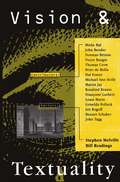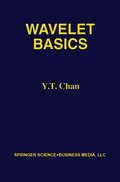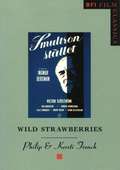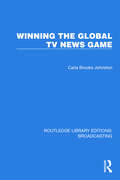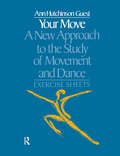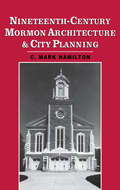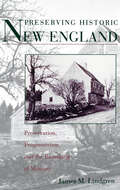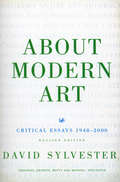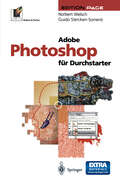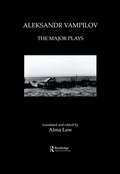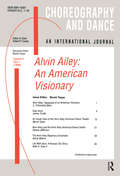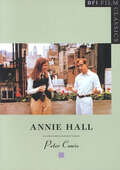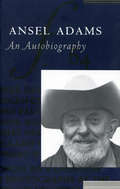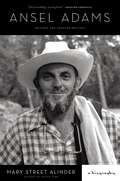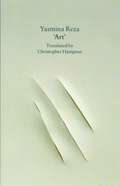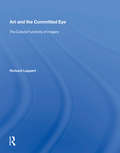- Table View
- List View
Vision and Textuality
This volume brings together the work of distinguished critics and art historians in order to reflect and assess the impact of current critical theory on the discipline and practice of art history. Centring on the intersection of questions of vision with the problematic of textuality, the book addresses how issues of politics, semiotics, psychoanalysis and historiography have contributed to the emergent terms and practices of the new art histories.
Visualization in Scientific Computing ’95: Proceedings of the Eurographics Workshop in Chia, Italy, May 3–5, 1995 (Eurographics)
by Riccardo Scateni Jarke J. Van Wijk Pietro ZanariniVisualization is nowadays indispensable to get insight into the huge amounts of data pro duced by large scale simulations or advanced measurement devices. The use of com puter graphics for scientific purposes has become a well established discipline, known as Scientific Visualization. Many problems still have to be solved, and hence the field is a very active area for research and development. This book represents results of the sixth in a well established series of international workshops on Visualization in Scien tific Computing organized by the EUROGRAPHICS Association in collaboration with CRS4 (Center for Advanced Studies, Research and Development in Sardinia), held from May 3 to May 5,1995, in Chia, Italy. The thirteen contributions selected for this volume cover a wide range of topics, ranging from detailed algorithmic studies to searches for new metaphors. A rough di vision can be made into the parts interaction, irregular meshes, volume rendering, and applications. Interaction in three dimensions is a challenging area for research. The use of three dimensional user interfaces for more natural manipulation of three-dimensional data and their visualization is natural, but is far from trivial to realize. Pang et al. investigate the use of common objects such as spray cans and carving knives as metaphors for visualiza tion tools, in order to provide an intuitive and natural three dimensional user interface. Gibson uses a voxel-based data representation, not only for visualization, but also for physical modeling of objects. A prototype system under development for haptic explo ration is discussed.
Wavelet Basics
by Y. T. ChanSince the study of wavelets is a relatively new area, much of the research coming from mathematicians, most of the literature uses terminology, concepts and proofs that may, at times, be difficult and intimidating for the engineer. Wavelet Basics has therefore been written as an introductory book for scientists and engineers. The mathematical presentation has been kept simple, the concepts being presented in elaborate detail in a terminology that engineers will find familiar. Difficult ideas are illustrated with examples which will also aid in the development of an intuitive insight. Chapter 1 reviews the basics of signal transformation and discusses the concepts of duals and frames. Chapter 2 introduces the wavelet transform, contrasts it with the short-time Fourier transform and clarifies the names of the different types of wavelet transforms. Chapter 3 links multiresolution analysis, orthonormal wavelets and the design of digital filters. Chapter 4 gives a tour d'horizon of topics of current interest: wavelet packets and discrete time wavelet transforms, and concludes with applications in signal processing.
Wild Strawberries (BFI Film Classics)
by Philip French Kersti FrenchWild Strawberries (1958) is probably Ingmar Bergman's most personal film and one which explores his relation to the history of Swedish cinema. Philip and Kersti French give a detailed account of Bergman's powerful and intense direction of the film. They set the film firmly in the context of Swedish life and culture. The authors also trace connections with the plays of August Strindberg, and the paintings of Edvard Munch and Carl Larsson.
Winning the Global TV News Game (Routledge Library Editions: Broadcasting #39)
by Johnston Carla BrooksWinning the Global TV News Game (1995) examines the worldwide TV news revolution of the 1990s, dealing with live TV news as an industry–consumer relationship. It’s a marketing approach – focusing on regional markets across the globe, looking at industry players and the hardware they had put in place. Much of this analysis is told by leading news media professionals who describe the latest thinking and newest developments in their own words.
Winning the Global TV News Game (Routledge Library Editions: Broadcasting #39)
by Johnston Carla BrooksWinning the Global TV News Game (1995) examines the worldwide TV news revolution of the 1990s, dealing with live TV news as an industry–consumer relationship. It’s a marketing approach – focusing on regional markets across the globe, looking at industry players and the hardware they had put in place. Much of this analysis is told by leading news media professionals who describe the latest thinking and newest developments in their own words.
Your Move: Exercise Sheets
by Ann Hutchinson GuestFirst published in 1995. A collection of sixty exercise sheets for activities in dance that include such areas as shifting body areas, body direction like tilting, displacement, and destination motion as well as contraction, elongation, folding, rotational twists, and the five forms of aerial steps.
Your Move: Exercise Sheets
by Ann Hutchinson GuestFirst published in 1995. A collection of sixty exercise sheets for activities in dance that include such areas as shifting body areas, body direction like tilting, displacement, and destination motion as well as contraction, elongation, folding, rotational twists, and the five forms of aerial steps.
Zenobia: Art Of Success; In The Ruins; Zenobia; Turn Of The Screw
by Nick DearThe Syrian desert. Third century AD. Zenobia, warrior Queen of Palmyra, moves her forces into battle with Aurelian, Emperor of Rome. Meanwhile, her son is engaged in bizarre chemical experiments with Porphyry, a philosophy student with his own secret.A story of love and adventure at the time of the decline of Imperial Rome as Zenobia makes a stand for independence against the Empire.Zenobia was produced by the Royal Shakespeare Company and premiered at the Young Vic, London, in August 1995.
Nineteenth-Century Mormon Architecture and City Planning
by C. Mark HamiltonThis book is the first comprehensive study of Mormon architecture. It centers on the doctrine of Zion which led to over 500 planned settlements in Missouri, Illinois, Utah, Idaho, Wyoming, Colorado, New Mexico, Arizona, California, Nevada, Canada, and Mexico. This doctrine also led to a hierarchy of building types from temples and tabernacles to meetinghouses and tithing offices. Their built environment stands as a monument to a unique utopian society that not only survived but continues to flourish where others have become historical or cultural curiosities. Hamilton's account, augmented by 135 original and historical photographs, provides a fascinating example of how religious teachings and practices are expressed in planned communities and architecture types.
Preserving Historic New England: Preservation, Progressivism, and the Remaking of Memory
by James M. LindgrenBy the first years of the twentieth century the memory of old-time New England was in danger. What had once been a land of small towns populated by tradition-minded Yankees was now becoming almost unrecognizable with a floodtide of immigrants and the constant change of a modernizing society. At the same time, cities such as Boston, Portsmouth, and Salem were bursting at the seams with factories, high-rises, and uncontrollable growth. During a period when the Colonial Revival and progressive movements held sway, Yankees asserted their influence through campaigns to redefine the meaning of their Anglo-American forebears. As part of the reaction, the modern preservation movement was founded by William Sumner Appleton, Jr., a privileged, old-blooded Bostonian. Resisting not simply this avalanche of change but the amateurish romanticism of fellow antiquaries, Appleton founded the Society for the Preservation of New England Antiquities in 1910. While examining SPNEA in the context of progressivism, Preserving Historic New England focuses on its redefinition of preservation to fit the methodology of science, the economy of capitalism, and the aestheticism of architecture. In so doing, preservation not only became a profession defined by those male worlds, but remade Yankee memory to accord with the modern corporate order.
5000 Designs and Motifs from India
by Ajit MookerjeeIncredibly rich treasury of authentic royalty-free designs adapted from artifacts of the Harappa culture, coins and pottery from South India, Ajanta and Bagh murals, Muslim monuments, Buddhist temples, textiles from Gujarat, Punjab, other regions, masks and tribal arts, much more. Immediately usable material or great resource for design inspiration. Introduction. Notes.
About Modern Art: Critical Essays 1948-96
by David SylvesterAbout Modern Art is the long-awaited collection of David Sylvester's essays on twentieth-century artists. This is not dry, remote, academic criticism: it has an immediacy and passion which leave one with an inspiring sense of the relevance and importance of art to life.
Adobe Photoshop für Durchstarter (Edition PAGE)
by Norbert Welsch Guido Stercken-SorrentiProfessionelle Anwender finden hier eine praxisorientierte Einführung in das Bildbearbeitungsprogramm Adobe Photoshop. Die Arbeitsweise des Programms wird knapp beschrieben, die praktische Anwendung ausführlich und anschaulich erklärt.
Aleksandr Vampilov: The Major Plays
by Alma LawFirst Published in 1996. Routledge is an imprint of Taylor & Francis, an informa company.
Aleksandr Vampilov: The Major Plays (Russian Theatre Archive Ser. #Vol. 6.)
by Alma LawFirst Published in 1996. Routledge is an imprint of Taylor & Francis, an informa company.
Alvin Ailey: An American Visionary (Choreography and Dance Studies Series)
by Muriel TopazDuring its three and half decades, the Alvin Ailey Company has left lasting markers on the playing field of American Modern Dance. It has established a reputation for precise but spectacular dancing, for depicting an African American ethos with sensitivity and elegance, and set standards for performance excellence. Ailey's choreography caused shock waves in the dance world of 1958 and continues to move audiences deeply. The company has also provided a paradigm for a modern dance repertory company. Contributors include Jennifer Dunning, Ronni Favors, Allan Gray, Denise Jefferson, Cynthia Sithembile West, Muriel Topaz, James Truitte, and Sylvia Waters. Eulogies written by David Dinkins, Carmen de Lavallade, Judith Jamison and Maya Angelou.
Alvin Ailey: An American Visionary (Choreography and Dance Studies Series #4.1)
by Muriel TopazDuring its three and half decades, the Alvin Ailey Company has left lasting markers on the playing field of American Modern Dance. It has established a reputation for precise but spectacular dancing, for depicting an African American ethos with sensitivity and elegance, and set standards for performance excellence. Ailey's choreography caused shock waves in the dance world of 1958 and continues to move audiences deeply. The company has also provided a paradigm for a modern dance repertory company. Contributors include Jennifer Dunning, Ronni Favors, Allan Gray, Denise Jefferson, Cynthia Sithembile West, Muriel Topaz, James Truitte, and Sylvia Waters. Eulogies written by David Dinkins, Carmen de Lavallade, Judith Jamison and Maya Angelou.
Annie Hall: A Nervous Romance (BFI Film Classics)
by Peter CowieFor an entire generation, 'Annie Hall 'embodied the notion of a New York peopled by sophisticated intellectuals - all sent up by the deadpan comedy genius of Woody Allen, writer, director and of course star. It also confirmed the sparkling acting talent of Diane Keaton as a partner for Woody on screen. The film has survived as a popular comedy, however, by virtue of Allen's inventiveness as a director and the timelessness of his satire. Peter Cowrie's study of 'Annie Hall 'recaptures the mood of the 70s, and examines the myriad imaginative touches that distinguish this film from other American productions of the period. The book also includes a glossary of the many cultural references which give the film its distinctively 'intellectual' tone.
Ansel Adams: An Autobiography
by Ansel Adams Mary Street AlinderDiscover this "evocative celebration of the life, career, friendships, concerns, and vision" of Ansel Adams, America's greatest photographer (New York Times)"No lover of Ansel Adams' photographs can afford to miss this book." - Wallace Stegner In this bestselling autobiography, completed shortly before his death in 1984, Ansel Adams looks back at his legendary six-decade career as a conservationist, teacher, musician, and, above all, photographer.Illustrated with eight pages of Adams' gorgeous black-and-white photographs, this book brings readers behind the images into the stories and circumstances of their creation. Written with characteristic warmth, vigor, and wit, this fascinating account brings to life the infectious enthusiasms, fervent battles, and bountiful friendships of a truly American original. "A warm, discursive, and salty document." - New Yorker
Ansel Adams: A Biography
by Mary Street AlinderFirst published in 1996, Mary Street Alinder's biography of Ansel Adams remains the only full biography of one of the greatest American photographers. Alinder is a respected scholar, and also had a close connection to Adams, serving as his chief assistant in the last five years of his life. The portrait she creates of him is intimate and affectionate; it is also clear-eyed. She takes on his difficult childhood in San Francisco, the friendships and rivalries within his circle of photographers, his leadership in America's environmental movement, his marriage, his affairs, and his not-always-successful fatherhood. Enriched by her uniquely personal understanding of Adams the man, she explains the artistic philosophy that, paired with his peerless technique, produced an inimitable style. Her biography is likely to remain unrivaled.This new edition will bring the classic up to date and includes research that reveals new information and a deeper understanding of his greatest photographs. It will also include thirty-two pages of reproductions of Adams's work and snapshots of the artist and close friends.
Ansel Adams: An Autobiography
by Mary Street Alinder Ansel AdamsDiscover this "evocative celebration of the life, career, friendships, concerns, and vision" of Ansel Adams, America's greatest photographer (New York Times)"No lover of Ansel Adams' photographs can afford to miss this book." - Wallace Stegner In this bestselling autobiography, completed shortly before his death in 1984, Ansel Adams looks back at his legendary six-decade career as a conservationist, teacher, musician, and, above all, photographer.Illustrated with eight pages of Adams' gorgeous black-and-white photographs, this book brings readers behind the images into the stories and circumstances of their creation. Written with characteristic warmth, vigor, and wit, this fascinating account brings to life the infectious enthusiasms, fervent battles, and bountiful friendships of a truly American original. "A warm, discursive, and salty document." - New Yorker
Art
by Yasmina Reza Christopher HamptonSerge has bought a modern work of art for a large sum of money. Marc hates the painting and cannot believe that a friend of his could possibly want such a work. Yvan attempts, unsuccessfully, to placate both sides with hilarious consequences. The question is: Are you who you think you are or are you who your friends think you are?
Art And The Committed Eye: The Cultural Functions Of Imagery
by Richard LeppertIn Art and the Committed Eye Richard Leppert examines Western European and American art from the fifteenth to the twentieth century. He studies the complex relation between the "look" of images and the variety of social and cultural uses to which they are put and demonstrates that the meaning of any image is significantly determined by its function, which changes over time. In particular, he emphasizes the ways in which visual culture is called on to mediate social differences defined by gender, class, and race. In , Leppert addresses the nature and task of representation, discussing how meaning accrues to images and what role vision and visuality play in the history of modernity. Here he explains imagery's power to attract our gaze by triggering desire and focuses on the long history of the use of representation to enact a deception, whether in painting or advertising. explores art's relation to the material world, to the ways in which images mark our various physical and psychic ties to objects. The author analyzes still life paintings whose subject matter is both extraordinarily diverse and deeply paradoxical—from flower bouquets to grotesque formal arrangements of human body parts. Leppert demonstrates that even in "innocent" still lifes, formal design and technical execution are imbued with cultural conflict and social power. is devoted to the representation of the human body—as subject to obsessive gazing and as an object of display, spectacle, and transgression. The variety of body representation is enormous: pleased or tortured, gorgeous or monstrous, modest or lascivious, powerful or weak, in the bloom of life or under the anatomist's knife, clothed or naked. But it is the sexual body, Leppert shows, that has provided the West with its richest, most complex, contradictory, conflicted, and paradoxical accounts of human identity in relation to social ideals.
Art And The Committed Eye: The Cultural Functions Of Imagery
by Richard LeppertIn Art and the Committed Eye Richard Leppert examines Western European and American art from the fifteenth to the twentieth century. He studies the complex relation between the "look" of images and the variety of social and cultural uses to which they are put and demonstrates that the meaning of any image is significantly determined by its function, which changes over time. In particular, he emphasizes the ways in which visual culture is called on to mediate social differences defined by gender, class, and race. In , Leppert addresses the nature and task of representation, discussing how meaning accrues to images and what role vision and visuality play in the history of modernity. Here he explains imagery's power to attract our gaze by triggering desire and focuses on the long history of the use of representation to enact a deception, whether in painting or advertising. explores art's relation to the material world, to the ways in which images mark our various physical and psychic ties to objects. The author analyzes still life paintings whose subject matter is both extraordinarily diverse and deeply paradoxical—from flower bouquets to grotesque formal arrangements of human body parts. Leppert demonstrates that even in "innocent" still lifes, formal design and technical execution are imbued with cultural conflict and social power. is devoted to the representation of the human body—as subject to obsessive gazing and as an object of display, spectacle, and transgression. The variety of body representation is enormous: pleased or tortured, gorgeous or monstrous, modest or lascivious, powerful or weak, in the bloom of life or under the anatomist's knife, clothed or naked. But it is the sexual body, Leppert shows, that has provided the West with its richest, most complex, contradictory, conflicted, and paradoxical accounts of human identity in relation to social ideals.
